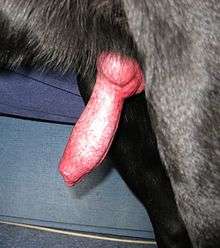Canine penis

Male canids have a bulbus glandis at the base of their penises.[1][2][3][4] The penis sometimes emerges from the penile sheath during sexual arousal.[5][6] During coitus the bulbus glandis swells up and results in a 'tie' (the male and female dogs being tied together). Muscles in the vagina of the female assist the retention by contracting.
At the time of penetration, the canine penis is not erect, and can only penetrate the female because it includes a narrow bone called the "baculum", a feature of most placental mammals. When the male achieves penetration, he will usually hold the female tighter and thrust deeply. It is during this time that the male's penis expands and it is important that the bulbus gland is far enough inside for the female to be able to trap it. Unlike human sexual intercourse, where the male penis commonly becomes erect before entering the female, canine copulation involves the male first penetrating the female, after which swelling of the penis to erection occurs, which usually happens rapidly.[7]
Male canines are one of the few animals that have a locking bulbus glandis or also known as a "bulb" or "knot", a spherical area of erectile tissue at the base of the penis. During copulation, and only after the male's penis is fully inside the female's vagina, the bulbus glandis becomes engorged with blood.[8] When the female's vagina subsequently contracts, the penis becomes locked inside the female.[9] This is known as "tying" or "knotting". While characteristic of mating in most canids, the copulatory tie has been reported to be absent[10] or very brief (less than one minute)[11] in the African wild dog, possibly due to the abundance of large predators in its environment.[12]
See also
| Wikimedia Commons has media related to Canidae penis. |
- Canine reproduction#Copulation
- Semen collection from dogs
- Urination#Canidae
- Canine transmissible venereal tumor
- Reproductive behavior of dogs
References
- ↑ MobileReference. The Illustrated Encyclopedia of North American Mammals: A Comprehensive Guide to Mammals of North America. pp. 977–. ISBN 978-1-60501-279-7.
- ↑ Kim Long (1996). Wolves: A Wildlife Handbook. Big Earth Pub. ISBN 978-1-55566-158-8. Retrieved 10 December 2012.
- ↑ L. David Mech (16 May 2012). Wolf. Random House Digital, Inc. pp. 172–. ISBN 978-0-307-81913-0. Retrieved 10 December 2012.
- ↑ Marshall Cavendish Corporation (1 September 2010). Mammal Anatomy: An Illustrated Guide. Marshall Cavendish. pp. 252–. ISBN 978-0-7614-7882-9. Retrieved 10 December 2012.
- ↑ Denis R. Lane; B. C. Cooper (2003). Veterinary Nursing 3e. Elsevier Health Sciences. pp. 72–. ISBN 978-0-7506-5525-5. Retrieved 28 February 2013.
- ↑ Michael S. Garvey, D.V.M.; Anne E. Hohenhaus, D.V.M. (10 December 2008). The Veterinarians' Guide to Your Dog's Symptoms. Random House Digital, Inc. pp. 194–. ISBN 978-0-307-49286-9. Retrieved 10 February 2013.
- ↑ Dan Rice (3 October 2008). The Complete Book of Dog Breeding. Barron's Educational Series. pp. 51–. ISBN 978-0-7641-3887-4. Retrieved 7 February 2013.
- ↑ "Semen Collection from Dogs". Arbl.cvmbs.colostate.edu. 2002-09-14. Retrieved 2012-01-29.
- ↑ Bekoff, M.; Diamond, J. (May 1976). "Precopulatory and Copulatory Behavior in Coyotes". Journal of Mammalogy. American Society of Mammalogists. 57 (2): 372–375. JSTOR 1379696.
- ↑ Kleiman, D. G. (1967). "Some Aspects of Social Behavior in the Canidae". Integrative and Comparative Biology. 7 (2): 365–372. doi:10.1093/icb/7.2.365.
- ↑ Creel, S. (1998-08-27), "Social organization and effective population size in carnivores", in Caro, T. M., Behavioral ecology and conservation biology, Oxford University Press, pp. 246–270, ISBN 978-0-19-510490-5
- ↑ Kleiman, D. G.; Eisenberg, J. F. (1973). "Comparisons of canid and felid social systems from an evolutionary perspective". Animal Behaviour. 21 (4): 637–659. PMID 4798194. doi:10.1016/S0003-3472(73)80088-0.
Further reading
- Johnson, RICHARD D., and RALPH L. Kitchell. "Mechanoreceptor response to mechanical and thermal stimuli in the glans penis of the dog." Journal of neurophysiology 57.6 (1987): 1813-1836.
- Carati, C. J., K. E. Creed, and E. J. Keogh. "Vascular changes during penile erection in the dog." The Journal of Physiology 400.1 (1988): 75-88.
- Hanyu, S., et al. "Mechanism of penile erection in the dog." Urologia Internationalis 42.6 (2010): 401-412.
- Hart, Benjamin L. "The action of extrinsic penile muscles during copulation in the male dog." The Anatomical Record 173.1 (1972): 1-5.
- Hart, Benjamin L., and Ralph L. Kitchell. "External morphology of the erect glans penis of the dog." The Anatomical Record 152.2 (1965): 193-198.
- Kutzler, Michelle Anne. "Semen collection in the dog." Theriogenology 64.3 (2005): 747-754.
- Purohit, R. C., and SIDNEY D. Beckett. "Penile pressures and muscle activity associated with erection and ejaculation in the dog." American Journal of Physiology--Legacy Content 231.5 (1976): 1343-1348.
- Howard E. Evans; Alexander de Lahunta (7 August 2013). Miller's Anatomy of the Dog. Elsevier Health Sciences. ISBN 978-0-323-26623-9.
- Gary England (18 October 2012). Dog Breeding, Whelping and Puppy Care. John Wiley & Sons. ISBN 978-1-118-41435-4.
- Klaus Dieter Budras (13 September 2007). Anatomy of the Dog. Manson Publishing. ISBN 978-3-89993-099-3. Retrieved 21 May 2013.
- Georg Mueller (1911). Diseases of the dog and their treatment. Franklin Press. p. 207. Retrieved 18 May 2013.
- Douglas H. Slatter (2003). Textbook of Small Animal Surgery. Elsevier Health Sciences. p. 1535. ISBN 978-0-7216-8607-3. Retrieved 18 May 2013.
- Bonnie V. Beaver (2009). Canine behavior: insights and answers. Elsevier Health Sciences. p. 200. ISBN 978-1-4160-5419-1. Retrieved 18 May 2013.
- Gerstenfeld (1989). The Dog Care Book: All You Need to Know to Keep Your Dog Healthy and Happy. Addison-Wesley Publishing Company. p. 27. ISBN 978-0-201-09667-5. Retrieved 18 May 2013.
- Elizabeth Aughey; Fredric L. Frye (15 February 2001). Comparative Veterinary Histology: with Clinical Correlates. Manson Publishing. pp. 172–. ISBN 978-1-84076-564-9. Retrieved 18 May 2013.